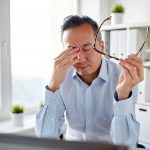Last updated on May 10th, 2021 at 03:59 pm
A study carried out in Brazil found there is a 6% increase in people with sleep apnoea who report having more severe symptoms in winter compared to summer. The average number of interruptions to sleep each hour also rises in the winter to 18 times an hour from 15.
The main symptoms of sleep apnoea are frequent interruptions to sleep, loud snoring, morning headaches, concentration and irritability issues and a sore or dry throat when you awake. If you are experiencing a worsening of your sleep apnoea symptoms during winter you should consult your doctor to evaluate why and to see if you should amend your existing treatment plan.

Why Sleep Apnoea May Get Worse in Winter
Sleep apnoea is a complex disorder and there may be a number of reasons why your sleep apnoea is getting worse during winter. Naturally during the colder months there is more illness and colds flying around for you to catch.
These can affect the sinus and cause nasal congestion, further blocking the upper airways while you sleep and adding to your sleep apnoea symptoms.
The colder weather sees drier air and this can also be exacerbated by some heating systems. Less moisture in the air can result in more discomfort and congestion in the airways as the mucous membranes in the nasal passage dry up. Using a wood burner to heat your home can also create air conditions which worsens your sleep apnoea symptoms.
Winter Adjustments to Help Sleep Apnoea
While studies point to an increase in reported severity of sleep apnoea symptoms in winter, it is worth remembering the main risk factors for the disorder include smoking — so it is important to kick the habit.
There are other adjustments which may lessen the impact winter may have on your sleep apnoea symptoms.
Firstly, it can be very tempting to hike up the thermostat in the home and make your rooms really hot. However, try to resist this temptation for the bedroom and look for a more comfortable cooler temperature which encourages sleep.
Admittedly, it can be hard to stay free of colds and illness during winter. But ensuring you maintain a good balanced diet and keep exercising even though the days are shorter helps boost your immune system.
The dark nights also signal less sunlight, an important source of vitamin D let alone a general feel good factor. Find time in the day to get outside, even if it is for a brief walk, as direct sunlight can help improve your sleep and improve your overall mood.
If you continue to struggle with worsening sleep apnoea symptoms over the winter months, then consult your doctor to see if you need to amend your treatment. If your symptoms are getting worse it means whichever treatment plan you are on will be less effective and this needs to be addressed.
There are a number of sleep apnoea therapy options available which help manage the disorder, of which continuous positive airway pressure (CPAP) therapy is a leading solution.
The equipment used in CPAP therapy including the mask have become more comfortable over the years, but winter can still lead to some additional challenges.

Maintaining your CPAP therapy over the winter months is essential to prevent the symptoms which lead to sleep apnoea returning and the serious health issues this can cause. The drier winter air can result in more discomfort in the airways and can put people off using their CPAP equipment every night.
However, by using a humidifier you can warm and moisten the air you are breathing through your CPAP mask. Most modern CPAP devices already come supplied with a humidifier which tend to have settings between 1 and 5 for you to select, depending on the level of moisture you desire.
In winter around 40% of CPAP users say they experience a dry mouth which can lead to other problems including inflammation, sinus infection, congestion and bad breath. Therefore, using a heated humidifier can be beneficial in reversing these issues.
One thing to look out for when using a humidifier is called “rainout”. This occurs when the temperature of the air going — although the CPAP device is warmer than the air in the room. As the temperature of the air drops water droplets form in the CPAP tubing which can get in the mask or splash out on your face. To prevent this you can keep your CPAP tube warm by covering it or by keeping it below your head level while sleeping.
CPAP masks come in different formats, but it can be best to wear a full-face mask in winter.
As you develop a cold, the congestion makes it harder to breathe through the nose and you start to breathe more through the mouth. If you only have a nasal mask, then the air from the CPAP device can be lost through the mouth, making the treatment less effective.
When you are losing air through the mouth it also means the warm, moist air from the lungs is not exhaled through the nose which can lead to dry nasal passages. A full-face mask during the cooler months can therefore make CPAP therapy more comfortable and make you more likely to persist with the treatment.
Although you should not overheat the bedroom, a cosy temperature with the windows shut helps maintain an ambient temperature of the air in the CPAP tubing.
It is also recommended to keep the tubing itself warm by keeping it placed beneath the bed sheets or placing a tubing wrap over it.
Make sure you maintain your regular cleaning of the CPAP equipment through the winter months to reduce the chance of illness from accumulated germs, as well as encouraging sleep by having fresher smelling accessories.
Don’t Give Up: Your Body Needs the Treatment!
It is true colds and sinus problems in winter can make breathing difficult and exacerbate sleep apnoea symptoms. You may feel the last thing you want to do when your airways are congested is to use CPAP which can be harder to tolerate.
Yet it is important to persevere with the therapy to ensure effective treatment and in using CPAP you are more likely to have a good night’s sleep, boosting your immune system to help rid you of your cold. CPAP can actually help break up congestion and relieve sore or dry throats.
If you do need to make your CPAP therapy more comfortable when you have a cold you can try a saline nasal spray or a decongestant to ease any inflammation in the airways.
There is no denying that the winter months can offer up increased challenges to sleep apnoea sufferers and the treatment they require such as CPAP therapy. However, by making slight adjustments and using some of the tips noted above you can continue to receive the essential treatment you need to reduce the symptoms of this serious sleep disorder throughout the colder months.



